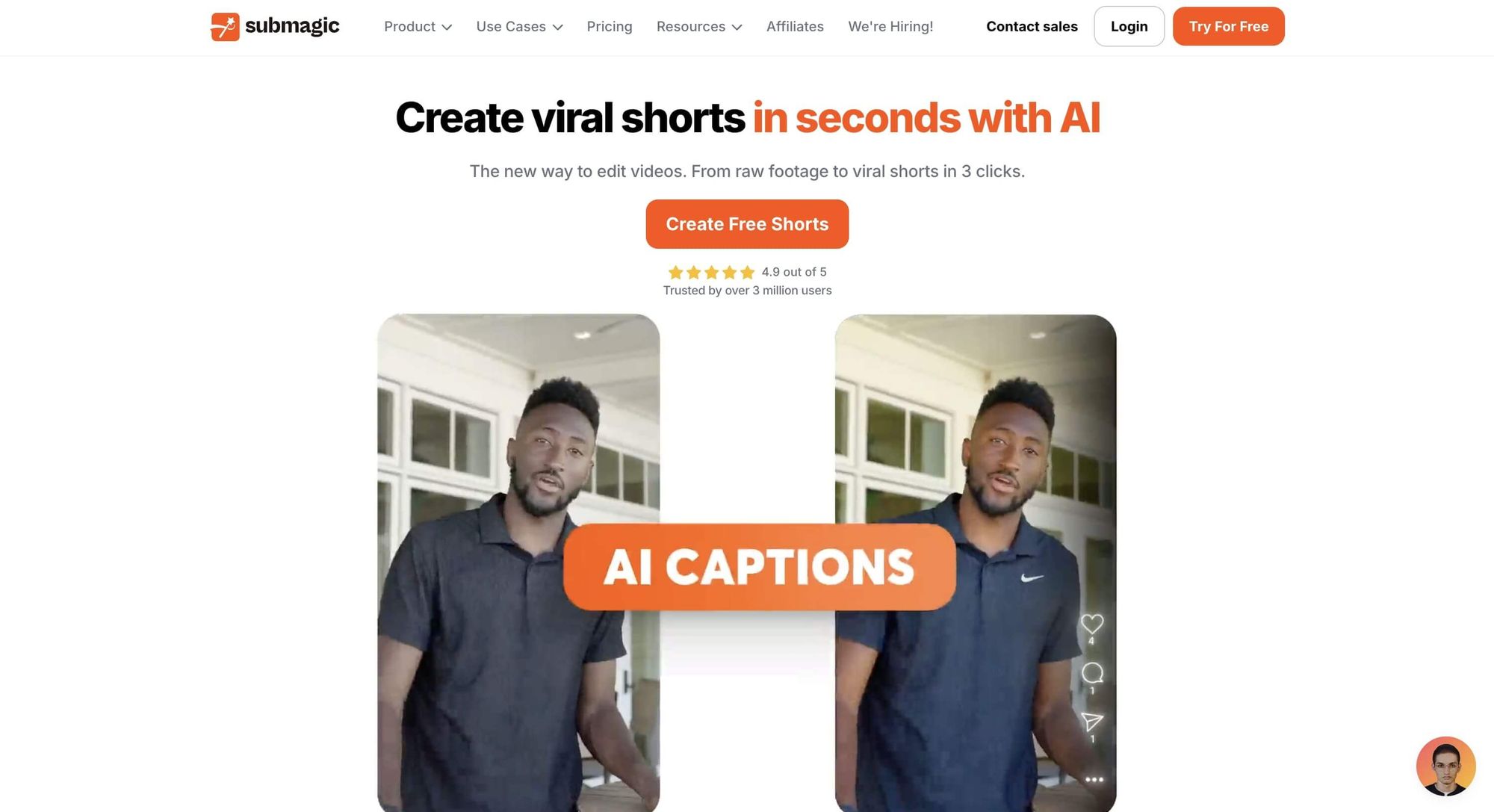Today's fast-paced business landscape, customer support plays a crucial role in ensuring customer satisfaction and loyalty. With the rise of AI technology, businesses are finding innovative ways to enhance their support systems and deliver exceptional service.
Resolving 80% of support conversations is not a dream, it has been achieved by one Crisp customer*.
This is not a rare case, it's happening more and more. In our top 100 most active Crisp customers, we see a median of 42% of conversations being automated.
Out of these 100 most active users, 46% haven't enabled AI-powered automations to answer customers' conversations.
Here lies a another truth : most companies have not yet fully embraced AI for their customer support.
As Crisp has recently been awarded among the top 50 AI apps over the world, it is time to let you know how you can :
- Get started with AI-powered ticket resolution.
- Build an AI that speaks and sounds just like your best support agent.
- Uncover KPIs shared from Submagic, a leading AI-powered video editing software.
Let's delve into the world of AI-powered customer support and uncover the key insights that can revolutionize your approach.
>>> Download the AI ROI KPI Cheat Sheets for customer support
The evolution of customer support
Customer support has evolved significantly from a purely human-driven, often slow and resource-intensive function, into a sophisticated, technology-powered cornerstone of customer experience.
The initial adoption of traditional chatbots marked an early attempt at efficiency, but they often fell short due to their scripted responses, lack of context awareness, and clunky handoff processes, which frustrated customers and broke conversational continuity as explained in this study from BCG dating from 2023.
This created a clear gap between the need for scale and the imperative to maintain quality. The true game-changer has been the integration of a sophisticated AI layer over these foundational tools.
Brought by the revolution led by OpenAI, AI generative experiences have changed the chatbot experiences. But also customers' expectations, going to an ever higher level.
This evolution is not about replacing human agents but moving towards a powerful synergy, what Gartner calls a "digital first, not digital only" model.
Modern AI now allows businesses to handle up to 80% of common inquiries automatically by understanding nuance, remembering past interactions, and escalating complex issues seamlessly.
This transformation empowers support teams to shift from being overwhelmed by repetitive queries to focusing on high-value, complex problem-solving and building genuine customer trust.
Company's knowledge has taken a key place in company's ability to train AIs the right way. More than ever, if companies are willing to get to the 80% mark, they shall improve the way they store, and manage public and private knowledge.
Building the AI brain: data sources and training for high-resolution rates
The principle of "leveraging existing internal content" is foundational, but its execution is what separates basic chatbots from high-resolution AI agents. To reach the goal of resolving 80% of inquiries autonomously, the AI must be trained on a comprehensive and well-structured ecosystem of data sources. This goes far beyond a simple FAQ page.
The data hub: fueling the AI with context
An effective AI support model draws from a multi-layered data sources, including:
- Structured Knowledge: This is your explicit company knowledge, such as product documentation, user manuals, and curated help center pages. It's the primary source for factual answers about features, pricing, and policies.
- Procedural Guides: Internal step-by-step troubleshooting guides, onboarding processes, and workflow documentation teach the AI how to solve common problems methodically.
- Historical Conversations: Past chat logs, email threads, and support tickets are a goldmine. They provide real-world examples of how customers phrase questions, what solutions worked, and the nuanced language your support team uses, which the AI can learn to emulate.
- Public-Facing Content: Your website, blog posts, and help center articles offer additional context and detail that can be woven into answers to provide a richer, more helpful response.
- Integrated System Data (via APIs/MCPs): By connecting to other systems (e.g., CRM, order management, billing), the AI can access real-time, personalized data to answer questions like "What's my order status?" or "What's my current balance?" without asking the customer for details.

Benefits of AI in customer support
AI brings a myriad of tangible benefits to customer support operations, directly impacting both efficiency and customer satisfaction. The primary advantage is a dramatic increase in operational efficiency, demonstrated by the ability to cut average response times from over an hour to just minutes, as seen in the Submagic case study.
This is achieved by automating repetitive tasks like FAQs, status checks, and product inquiries, providing instant, 24/7 answers. This automation leads to enhanced scalability, allowing businesses to manage high volumes of conversations—3,500+ per month, for instance—without proportionally increasing agent headcount.
In fact, top performers see a significant reduction in inbound contacts (e.g., 65% fewer), as routine issues are resolved at the source thanks to tools such as Overlay, the website search widget powered by AI.
Crucially, this Automated resolution for common queries enables support teams to focus their expertise on more complex and sensitive issues that require human empathy and decision-making, such as troubleshooting, disputes, and expert guidance.
The result is a win-win: customers get faster, more accurate answers for simple questions, while agents experience higher job satisfaction by concentrating on meaningful work, all while key metrics like Customer Satisfaction (CSAT) are maintained or even improved.
Optimizing workflows with AI and the next frontier: MCPs
AI is revolutionizing support workflows by injecting intelligence and automation at every stage, moving beyond simple question-answering to actively streamlining operations.
This begins with foundational optimizations: Smart Routing uses AI's intent detection to direct complex issues like refunds or technical problems to the right human agent instantly, while automated workflows handle routine tasks like FAQs, status checks, and proactive communications.
The next evolutionary leap in this optimization is emerging with technologies like Model Context Protocols (MCPs).
While current AI excels at managing and routing information, MCPs promise to connect AI directly to a company's core systems, enabling it to autonomously execute multi-step, actionable tasks.
Imagine a customer requesting, "Please cancel my subscription and issue a prorated refund." Today, this requires an agent to switch between multiple apps.
With MCPs, the AI could securely authenticate the user, execute the cancellation in the billing system, calculate the refund, and trigger the payment—all within the chat interface without human intervention.
This represents the ultimate workflow optimization: a shift from an AI that assists the workflow to one that is the workflow.
It transforms the support agent's role from a performer of repetitive tasks to a supervisor and exception-handler, unlocking unprecedented levels of efficiency and allowing businesses to resolve not just conversations, but complete customer intentions end-to-end.
The imperative of AI training: the path to 80% ticket resolution
Simply uploading documents is not enough. Consistently achieving an 80% auto-resolution rate requires a deliberate and continuous training regimen. This is because AI resolution is a direct function of the quality and relevance of its training data.
- Intent mapping and grounding: The AI must be trained to accurately map a customer's vague question ("It's not working!") to a specific, documented intent (e.g., "password reset failure"). This process, called "grounding," ensures the AI's answers are not just plausible but are directly pulled from and validated by your trusted knowledge base, minimizing hallucinations.
- Continuous review and improvement: Top-performing teams don't set and forget. They conduct weekly reviews of conversations the AI handled, failed on, or escalated. These "failure points" become the most valuable training data. By retraining the AI with these uncovered gaps, new intents, unclear phrasing, or missing information, you create a virtuous cycle of improvement.
- Quality over quantity: A small, highly relevant, and well-organized knowledge base will outperform a vast, messy, and outdated one every time. The training process involves pruning incorrect information, updating outdated procedures, and refining answers for clarity and actionability.
In essence, the 80% resolution rate is not a default setting; it is a milestone achieved by strategically building a comprehensive "data hub" and committing to an ongoing process of training, analysis, and refinement.
The AI becomes a dynamic repository of your collective company knowledge, capable of delivering instant, accurate, and consistent service at scale.
But what do we have left for humans and the emotional connection between two humans?
The human-touch in AI-powered support remains central.
The importance of human touch in AI Support
While AI is a revolutionary tool for scaling customer support, it operates on logic and data patterns. The human touch remains the irreplaceable soul of customer experience, providing the empathy, judgment, and emotional intelligence that machines cannot replicate.
The most successful support workflows, therefore, are not fully automated but are augmented, adopting a "digital first, not digital only" philosophy.
This balanced approach strategically leverages the strengths of both to cater to the full spectrum of customer needs.
The strategic division of labor
Explained by Adam Smith, labor division into smaller, specialized tasks improves efficiency and productivity. The synergy between AI and humans creates a powerful division of labor:
- AI handles repetitives queries at scale: It excels at providing 24/7 availability for FAQs, order status checks, refund, 1-st level support, and policy information. This efficiency is crucial, resolving up to 80% of common inquiries instantly and freeing human agents from the tedium of repetitive tasks.
- Humans solve complex and sensitive Issues: human agents are essential for troubleshooting unique problems, managing disputes, and navigating sensitive conversations. These scenarios require expert decision-making, emotional nuance, and the creativity to think outside the pre-defined pathways of an AI.
The human qualities AI cannot replace
Human agents bring critical, uniquely human skills to the table:
- Empathy and emotional connection: When a customer is frustrated, anxious, or upset, a genuine expression of understanding from a person builds trust and de-escalates tension in a way that an AI's "I understand your frustration" cannot.
- Creative problem-solving: AI is bound by its training data. Humans can connect disparate pieces of information, draw on intuition and experience, and devise novel solutions for problems that have never been encountered before.
- Ethical judgment and responsibility: Complex situations involving privacy, financial compromises, or ethical dilemmas require a human's moral compass and sense of accountability.
Driving business success with AI:
Businesses that embrace AI in customer support gain a competitive edge by delivering superior service, reducing response times, and building stronger customer relationships.
The case for SubMagic
Submagic is an AI tool that automates the creation of stylish video captions.

How Submagic used Crisp for AI-powered support:
Due to its rapid growth Submagic faced a lot of struggle in terms of customer support :
- High volume: Over 3,500 conversations per month.
- Slow response times: An average response time of 1 hour and 26 minutes, which was overwhelming their support agents and annoy customers'.
By implementing Crisp AI, Submagic automated responses to common inquiries (like FAQs, and product questions) and used smart routing to direct complex issues to human agents.
This led to:
- A 95% faster response time (from 1h26m to 5m33s).
- A 65% reduction in new conversations created thanks to Crisp Overlay, the website search widget..
- Stabilized customer satisfaction (CSAT) around 4.3 .
Below, a short explanations shared by Stefan Sekovski, customer support specialist at Submagic, on how they've been leveraging AI to improve customer support.
We've reduced the timing by being able to quickly identify the importance of the user's case. We have clear categorization & prioritization, we use automation and self-service with the help-desk articles our AI help library and with the AI bot answering tier1 questions on the help live-chat. Our agents are able to resolve any issues by having clear decision trees and case examples that they can review for assistance. We have internal com channels (WhatsApp/Discord) where we report/escalate issues and have them resolved super fast. We use also shortcuts to reduce the time between replying and increase the communication efficiency.
In summary, Crisp's AI helped the company to automate and scale its customer support, enabling it to grow efficiently to $8M in Annual Recurring Revenue (ARR).
Conclusion
In conclusion, AI is revolutionizing customer support by offering a blend of automation and human interaction that enhances operational efficiency and customer satisfaction. By leveraging AI technologies, businesses can transform their support systems, drive business success, and deliver exceptional customer experiences in today's digital age. Embrace the power of AI in customer support to stay ahead of the curve and meet the evolving needs of your customers.
*As per Crisp customer discretionary request, we can't cite its name but we can say is a customer striving in the ecommerce industry.









